(View Complete Item Description)
Through a series of three lessons and one activity, students are introduced to inertia, forces and Newton's three laws of motion. For each lesson, a combination of class demonstrations and PowerPoint® presentations are used to explain, show and relate the concepts to engineering. Lesson 1 starts with inertia, forces and Newton's first law of motion. Lesson 2 builds on lesson 1 with s review and then introduces Newton's second law of motion. Lesson 3 builds on the previous two lessons with a review and then introduces Newton's third law of motion. In a culminating activity, students apply their knowledge of forces, friction, acceleration and gravity in an experiment to measure the average acceleration of a textbook pulled along a table by varying weights, and then test the effects of friction on different surfaces.
Material Type:
Full Course,
Unit of Study
Authors:
Elizabeth Anthony,
Jacob Teter,
Scott Strobel




















